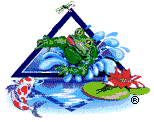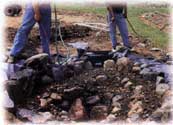

Your Water Gardening Specialists!
|
|
Spring Startup...
SPRING CLEAN-OUT AND START-UP Spring clean-outs can be started once the ice is no longer covering the pond's surface. Listed in this section are steps for completing a spring clean-out, as well as the factors that determine how extensive the clean-out will have to be. Full clean outs should be completed no more than once a year. Read through these options and determine which clean-out is best for you. Using no attachments on your hose, wash the stones and gravel starting at the ponds perimeter. Work your way to the bottom slowly allowing trapped sediment and muddy water to travel to your pump. FULL CLEAN-OUT: You will achieve the best water quality results in your pond by completing a full clean-out in the spring. A full clean-out is completed on ponds that have a heavy fish load, accumulated leaf and debris build-up through the winter, or have heavy algae growth. If you desire to clean algae off your stones, rent a pressure washer rated at approximately 1500 p.s.i. Don't be too thorough since some algae is good. Check with your local hardware store or rental agency regarding availability of pressure washers. Pumping out the water: The first step of the clean-out is to pump out the pond using a submersible pump (you can use your waterfall pump) and discharge hose. Wait until a good portion of water is removed from the pond before attempting to catch the fish. The fish will be much easier to net once the water level has dropped. Place the fish in large buckets or containers filled with pond water.
Be careful not to leave your fish in the temporary containers for extended periods of time: lack of oxygen and a build up of toxins will occur. The clean-out should be completed in no more than one day for the safety of the fish. (Make sure you cover their buckets so they don't jump out.) Continue to pump the remaining water out of the pond once all of the fish are removed.
Washing your stones: The submersible pump and discharge hose should remain at the bottom of your pond to continuously pump out the dirty water. Once this is complete, remove the pump and discharge hose from the pond. Remove any remaining leaves and debris from the pond. Spread the gravel that was displaced back over the liner. Gravel can be added to any areas in and around the pond where the liner is showing. Now begin to fill the pond with a garden hose. To save time the remaining steps can be completed while the pond is filling.
PREPARING THE BIOFALLS® AND SKIMMER: The pump and discharge hose can also aid in cleaning debris and dirty water from your BIOFALLS® and Skimmer. Larger leaves and debris that are not pumped out can be removed with a net or by hand. Pressure-wash the larger debris off the BIOFALLS® filter mats and biological media bags before installing into BIOFALLS®. The filter mats are designed to last about two years. Filter mats may be discoloured and appear dirty and old, but will work just fine in your filters. Replace old filter mats if they begin to tear or fall apart. Ask your installer or local garden centre about replacement filter mats. Set the filter mats on to of the support pipes found near the bottom of the BIOFALLS® and the middle of the skimmer. Next, lay the bags containing the biological media on top of the filter mats. Spread the media across the entire surface of the filter mats so water is forced to pas through the media. The pump, skimmer filter mat, and debris net can be installed back into the skimmer. The pump can be turned on as soon as the water reaches the desired level. The fish can be transferred into the pond while it is filling. Be sure to add dechlorinator if your tap water contains chlorine. Float the fish in a bucket or container for 20 minutes to a half an hour periodically splashing new water into the buckets. This will allow the fish to adjust to the temperature difference. PARTIAL CLEAN-OUT: A partial clean-out may be completed if your pond does not have a heavy fish load, excessive debris, algae build-up, or was installed late in the fall. However, the best water quality results occur when a full clean-out is completed. A less extensive clean-out does not require pumping out all of the water and pressure washing the rocks. Simply change 25-50% of the pond's water volume. Removing a portion of the water will reduce fish waste and toxins in the pond. Place your pump and discharge hose in the pond and pump out the desired amount of water. The fish will not have to be transferred for this type of clean-out Use a net to remove leaves and debris from your pond. Begin to fill your pond. The partial clean-out uses the same steps to prepare the BIOFALLS® and Skimmer as the full clean-out. Spring Memo to: Aquascape Pond Owners February 15, 2002. Phone us at 1-866-581-7663 to receive our latest Catalogue by mail. [ Top ] |
Naturalizing Tips...To develop the look of a natural pond you can: - Go with the native vegetation that thrives in your area. - Repeat mass groupings using one or two kinds of plants, especially grasses and reeds. - Surround your pond with trees and shrubs that naturally occur near water, like alders, river birches, dogwoods and willows. - Plant vigorous natives in the shallow margins, and make sure the center of the pool is more than eighteen inches deep, so natives won't over run the pond. |
|
||




